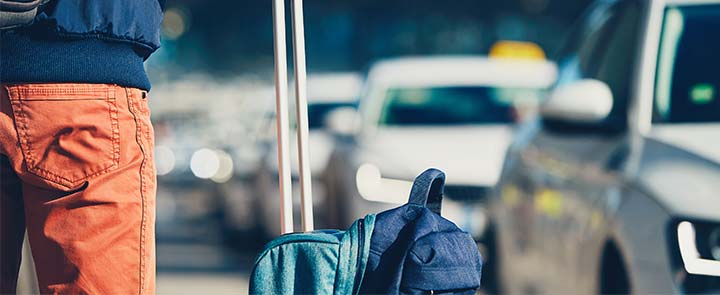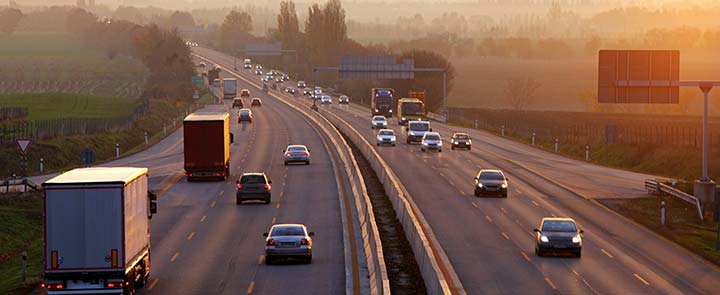
No country is more synonymous with driving than the USA. From its major coastal cities to the rural interior, empty deserts and tropical lowlands, a road trip across the country can feel like you’re visiting different nations with their own identities. Learn all you need to hit the road safely with our no-nonsense guide to driving in the USA.
While America’s roads are generally safe, and most trips are incident-free, getting to grips with local driving laws will help you avoid any trouble on the road.
Before you hit the highways, let’s cover the essentials that visitors ought to know before driving in the USA.
Roads in the USA
There are over four million miles of roads in the USA and most of these are two-lane rural highways. That said, less than 0.5% of the US is covered by paved roads. America’s road network is generally good, although a lack of infrastructure investment over the past few decades has resulted in a lot of unfixed wear and tear, so watch out for potholes while driving.
Knowing the different kinds of roads in the USA is very useful when working out your route. Let’s look at the main types of roads in the USA.
Interstate highways
These are the main arteries that connect the country. American interstates are high-speed roads with no cross traffic or junctions; you normally join the traffic via an on-ramp. Only automobiles are allowed on Interstates – bicycles, for instance, are prohibited.
Interstates are laid out in a rough grid that traverses the country. Even numbers indicate east-west routes (lower numbers on the southern coast and Mexican border) and odd numbers indicate north-south routes (lower numbers on the Pacific coast). Interstates have a two-digit number, while roads with a three-digit number are feeder roads for a major interstate.
You’ll recognise interstate signs by their iconic blue shield with a red crest.
Freeways
Freeways are a kind of Interstate road too, but they are often found in urban areas and are designed for high-speed driving. They also never have toll booths – hence the name freeway.
Numbered highways
Also known as US Routes or US Highways, American numbered highways were the original interstates, until they were replaced in the 1950s. You’ll see junctions and traffic lights as you drive along them. Like Interstates, highways are also laid out in a grid across the country, but with the numbering system reversed.
You’ll recognise a numbered highway by the white badge on a black background.
State highways
These are the next level down and are usually quieter roads. State highways often have a lower speed limit, and are designed and managed by the state. The typical sign is a white circle on a square black background, although many states have their own unique design – such as an outline of the state with the road number in the middle.
Scenic byways
Scenic byways are, as the name suggests, scenic routes which are maintained by the state. Many traverse national parks and other areas of interest, and usually have their own unique signage.
How to drive in the USA
If you’ve not driven on the right before, this will be the biggest thing to get used to, but if you hire an American car, everything will be set up for driving on this side. When renting a car, think about where you plan to drive and the season.
Most cars in the US are automatic, so you won’t be using a gear stick.
Many US roads could do with some resurfacing, so watch out for potholes. Also, America has almost no roundabouts – instead people will enter traffic at junctions. Many accidents happen at junctions when drivers don't spot other cars coming into the lane, so try to slow down and make sure anyone entering traffic has seen you – the same goes for when you enter the flow.
USA driving rules
Drivers and passengers must wear seatbelts and abide by strict speed limits. In most states, the alcohol limit for drivers is 0.08% blood alcohol concentration but some states issue penalties for drivers with a blood alcohol concentration of 0.05% (these are less severe).
Most states have the same rules, but you should double check for any idiosyncrasies with that state’s Department for Motor Vehicles.
What side of the road does America drive on?
Americans drive on the right-hand side of the road. If you rent a car, it will be set up for right-side driving, so you’ll need to adjust to the steering wheel being on the left-hand side of the car.
Who has right of way?
America has some unfamiliar rules when it comes to right of way.
- Whoever arrives at a junction first gets to go ahead
- You can turn right on a red light – as long as you briefly stop the car before turning right
- Drivers can overtake on either side on multi-lane routes
- It is the custom to allow people on slip roads space to enter
- Pedestrians only have the right of way at any specially designated pedestrian crossings
What is the speed limit in the USA?
The maximum speed limit on rural interstate highways is 70mph, with a 45mph minimum.
On four-lane divided highways, the limit is 65mph, and on all other highways it’s 55mph.
If you are driving through a designated school zone, you must drop to 15mph. These aren’t always clearly signposted, so pay attention in any urban areas. Many highway traffic police will hide in bushes waiting for speeding cars.
Driving in adverse conditions
Tourists driving in the USA should be able to avoid any unfortunate incidents by using common sense – if a road is flooded, avoid it, if there’s fog, slow down. Check the weather in advance. If you’re driving in snowy conditions, take sensible precautions, such as packing snow chains and a torch. In hurricane season, listen to the news for warnings and advice – if the police tell people not to drive, don’t do it.
Other important rules for driving in the USA
By and large, you should be fine following common sense, but make sure you abide by the following driving rules:
- Watch out for High Occupancy Vehicle (HOV) lanes. They’re restricted to vehicles carrying a minimum number of passengers. Penalties for using them illegally can be high.
- Don’t park in the following places: disabled spaces (unless you’re authorised to do so), in front of red or yellow kerbs, on a white line at a bus stop or within 10ft either side of a fire hydrant.
- If you’re travelling with a baby or young child, make sure they’re travelling in an approved car or booster seat.
- Look out for stationary school buses with flashing lights. It’s illegal to overtake them.
Driving hazards in the USA
One of the major causes of accidents in America is people not spotting one another when entering state highways, so always take precautions at junctions. Other hazards to watch out for include:
- Deer and large animals wandering into the road
- Getting lost – always bring a map in case your GPS fails
- Severe storms – generally it’s best to avoid driving and head for shelter
If anything goes wrong while you’re driving, you should call your rental car company. If it’s an emergency, the US emergency services can be contacted on 911.
More information
For further reading, your first stop should be the US government’s web page for visiting drivers or check out Rough Guides.
Do you need to make a claim?
If you’ve suffered damage to or loss of your hire vehicle due to theft, and you’ve purchased an insurance4carhire hire car excess insurance policy, we’re ready to help.
Related Guides

A Guide to Car Hire Costs
We like to think our car excess insurance is nice and straightforward. Your car rental agreement, however, might not be so easy to understand. With this in mind, we’ve put together a guide to car hire costs.

A Guide to Car Hire from the Airport
There are thousands of car rental desks across airports round the world, competing against each other in small spaces. In this guide, we’ll explore whether it could be more beneficial to leave the airport before hiring a car for your trip.

Top Tips for Driving a Hire Car Abroad
Having a hire car on holiday could save you the hassle of sorting out transfers. Not only that, it offers you the freedom to really explore and get to grips with your holiday destination...


